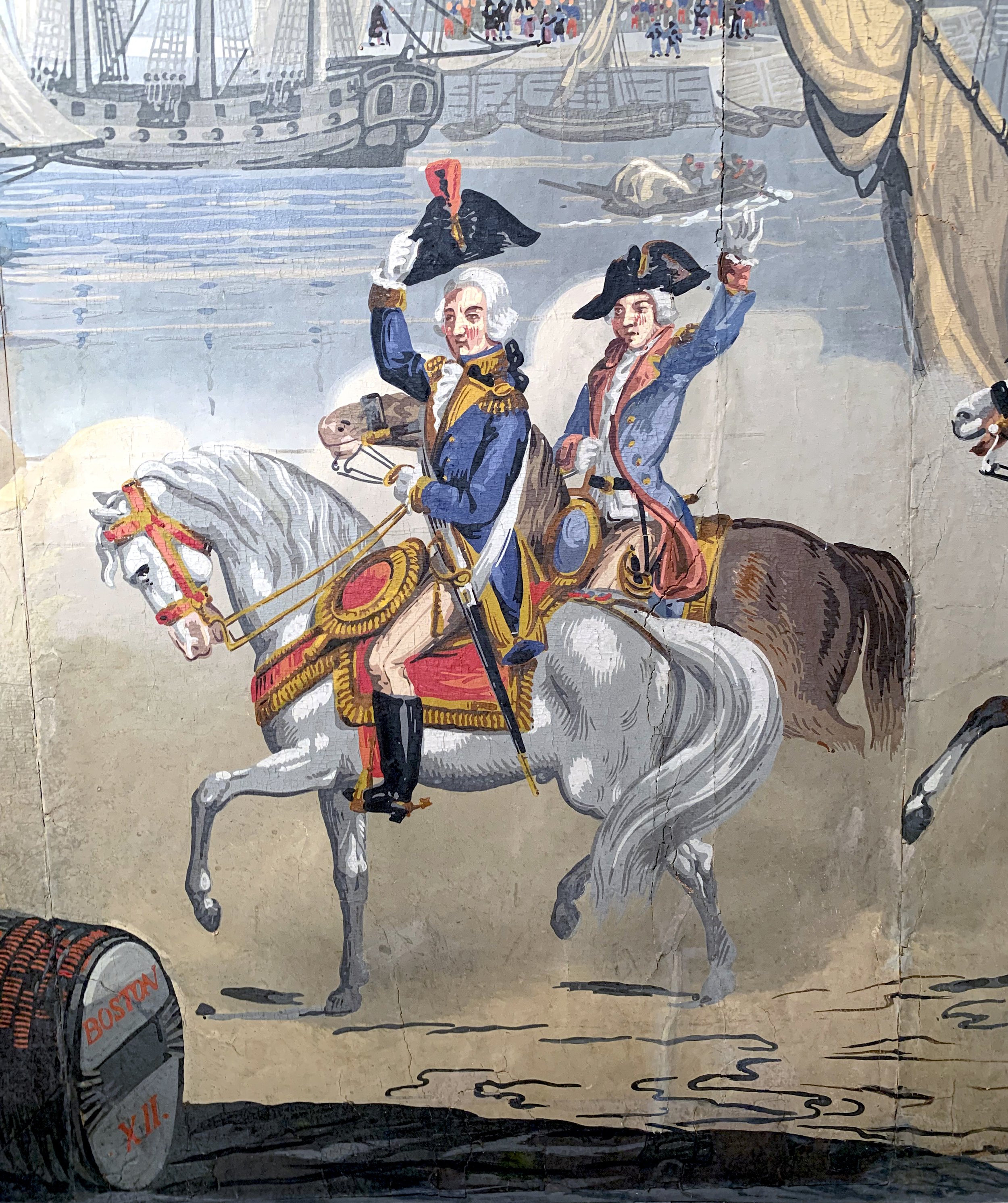Scenic Wallpaper was honored to be chosen for the restoration of a historic Zuber wallpaper at Fraunces Tavern Museum in Manhattan’s Financial District, an important landmark and a treasure of New York City.
After restoration
Built by the De Lancey family between 1719 and 1722 and sold to Samuel Fraunces in 1762, Fraunces Tavern and Museum is the oldest standing structure in Manhattan. The building has taken many forms over the centuries, being used among other things as a private residence, a dance school, a boarding house, and as one of the most important taverns of the Revolutionary War.
Taverns like Fraunces were important community meeting places in the 18th century, where residents and travelers could exchange knowledge and the news of the day. Several New York City clubs and organizations held meetings at Fraunces Tavern, including the New York City Sons of Liberty and the New York Society Library, and it served as the founding place of the Provincial Congress in 1775, the temporary colonial government during the Revolution. The Provincial Congress held a banquet in the Long Room on June 18, 1776 to show appreciation for General George Washington and his officers for their defense of the colony.
On November 25, 1783, British troops left New York City, the last American city to be occupied. This day would be later be referred to as Evacuation Day. George Washington led the Continental Army in a parade through the city, and Governor George Clinton’s Evacuation Day celebration was held at Fraunces Tavern.
December 4, 1783, nine days after the last British soldiers left America, George Washington gave his farewell address to the officers of the Continental Army in the Long Room of Fraunces Tavern, a significant event in American History.
The Sons of the Revolution in the State of New York, Inc. was founded in the Long Room in 1883 to commemorate this event and to preserve the history of Fraunces Tavern and its important place in American History.
Restoration of Fraunces was completed in 1907, and on December 4, the anniversary of Washington’s Farewell speech, the Museum and Tavern were dedicated and opened to the public. In 1965, 54 Pearl Street was designated as a New York City Landmark.
Appropriately, Zuber's War of Independence was installed in the Clinton Room on the 2nd Floor, donated in 1968 by Dr. George Clinton Andrews. The 32 non-repeating panels of this scenic wallpaper were printed by Zuber with an amazing 2300 hand-carved wood blocks and 360 colors.
Scenic Wallpaper was contacted to clean and restore this historic wallpaper. As far as we know, the Zuber paper had not been conserved since it was installed in the late 1960s. We removed a great amount of surface dirt and grime, changing the paper dramatically and bringing back some of the original color and brightness.
Much of the paper was very fragile so we had to secure the paper in place. This is a tedious process of finding and securing loose areas and delicately gluing them back down and securing them without damaging the surrounding areas.
Many areas had cracked and we had to fill the cracks and in-paint to disguise the repairs. Other areas of paint had flaked off or were discolored due to staining. These were fixed as well.
Before restoration, chipped paint and water stains
Before restoration, cracks in wallpaper
Before restoration, cracks in wallpaper
Before restoration, flaked paper
After filling in cracks
After filling in cracks
After filling in cracks
Before restoration
After restoration
Before restoration
After restoration
Before restoration
After restoration
Before restoration
After restoration
Before restoration
After cleaning and filling in cracks
After restoration
Zuber’s War of Independence was first printed in 1852. The panels illustrate important moments in the American Revolution, including the capture of a British stronghold by American forces on Weehawk Hill, the surrender of British General Cornwallis at Yorktown, the triumphant arrival of General Washington into Boston, and two battle scenes in front of the Natural Bridge and Niagara Falls.
After restoration
The Surrender of Cornwallis to Washington at Yorktown or The Capitulation: General Cornwallis is handing his sword to General Washington in defeat. The triumphant American troops are contrasted with the dour English soldiers on the right of the panels. One soldier is crying into the British Flag, another is bowed in disgrace and a third is has his arm in a sling. Zuber emphasized the French contribution to the war showing the Marquis de Lafayette and French soldiers in uniform.
Natural Bridge and Niagara Falls: George Washington leads a charge against the British Soldiers, who fall back and retreat under the crush of the American forces.
The Red Coats are in front of the Natural Bridge in the Shenandoah Valley of Virginia, which was regularly declared by writers of the late 18th and early 19th centuries to equal Niagara Falls as one of the great natural wonders of America.
After restoration
After restoration
After restoration
After restoration
After restoration
Washington’s Entry into Boston Harbor: The American Flag is flying high from every church, spire and boat in the harbor. This incredible attention to detail is what has made Zuber wallpapers so famous. Washington on a white horse tips his hat to the excited onlookers, followed on horseback by other heroes of the Revolution and a representation of Tipu Sultan who was fighting the British in India and who was followed closely by the founding fathers.
After restoration
After restoration
After restoration
After restoration
Battle at Weehawken, NJ with New York City: The foreground features General Lafayette storming the British Fort, surrounded by American Militia and Volunteers. Lafayette is shown with sword in hand, leading the charge and grabbing the canon.


































